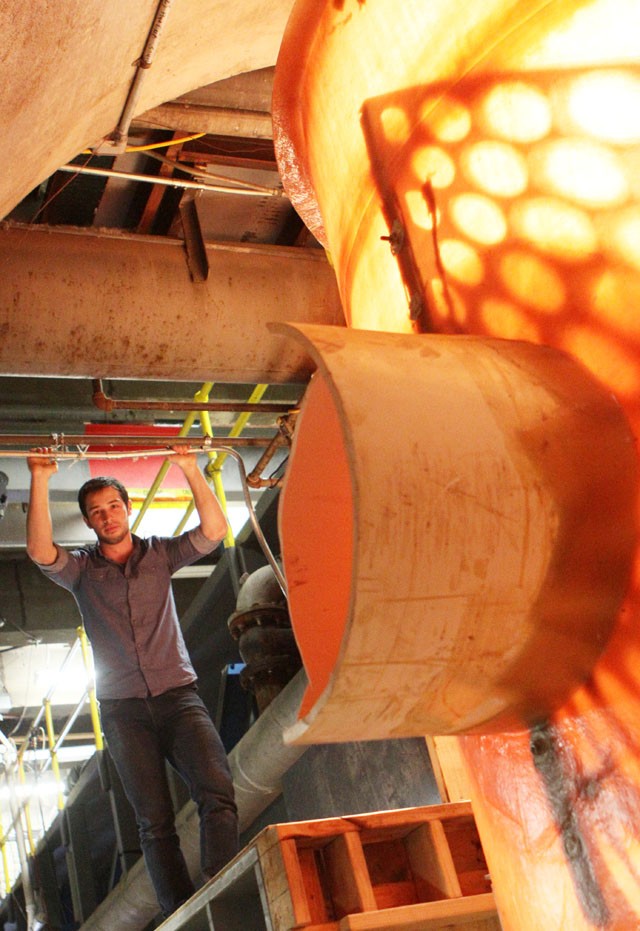The Teenage Mutant Ninja Turtles would have probably preferred cleaner storm sewers, and at the University of MinnesotaâÄôs St. Anthony Falls Laboratory, a group of researchers has found a solution.
The SAFL Baffle, as itâÄôs known to researchers at the lab, isolates pollutants in storm water and protects the biological cycle in large bodies of water. ItâÄôs a steel screen thatâÄôs installed in manholes. The research will culminate in a spinoff company, Upstream Technologies, next year.
Pollutants and trash, including metals and oils, get washed down storm drains following a big rainstorm, and eventually to overwhelmed storm sewers. The “nasty soup mix” can flow down sewer pipes and end up in lakes and rivers, graduate research assistant Kurt McIntire said.
Untreated storm water causes problems âÄî this is where the baffle helps.
“ItâÄôs messing up the biological cycle in lakes,” McIntire said. “[The debris in stormwater] promote the growth of algae,” which feed off of the oxygen in lakes and can kill fish and other living organisms.
In lakes, the brown color of the water is from dirt particles that have flowed out of the sewers, McIntire said. Other debris that can flow into bodies of water include cigarettes and leaves. Cigarettes are the most common waste, by number, while leaves are the most common by volume, he said.
At the foot of the Mississippi River, where it joins the Gulf of Mexico, thereâÄôs a dead zone, where nothing lives because of pollutants that have traveled downstream.
“We are part of this problem,” McIntire said.
A lot of products are already available for purchase by municipalities to clean stormwater, but most are very expensive.
“To give cities an option that is cheaper, effective and easy to install and maintain can really make a difference because we can put more of these baffles into the ground,” McIntire said.
McIntire estimates that the SAFL Baffle is one-tenth the cost of installing anything similar thatâÄôs available on the market now.
The city of Bloomington is the researchersâÄô first customer. It bought four baffles to be installed directly above the Minnesota Valley Wildlife Refuge for approximately $22,000, said Steve Segar, a civil engineer for the city.
Other products can cost up to $50,000 each, said Omid Mohseni, a University adjunct researcher who has been a part of the project from the start.
Several other cities have already put an investment into the invention, which will lead to a startup company by the UniversityâÄôs Office for Technology Commercialization.
Minneapolis, St. Paul, Blaine and Prior Lake have expressed interest or have plans to purchase and install the baffles, Mohseni said.
“ItâÄôs fairly unique,” Segar said.
Other technologies Bloomington has tried include swirl technologies to try to slow down the flow of water and let sediments drop out, but the problem with trash flowing downstream during high-flow periods still remains.
“The baffle looks to be more economical and easier to maintain,” Segar said. “It should help improve stream water.”
“ItâÄôs a very simple design,” Mohseni said.
The Minnesota Department of Transportation gave the lab $257,000 to assess the performance of standard sumps, the place where two storm sewers connect, as effective stormwater treatment devices.
“When we were doing the work, we were not thinking of coming up with a design that would have such an impact,” said Mohseni. “In some sense [the design] was an accident.”
The next step in the research is to look at how trash, such as large plastic bags, can clog the baffle. “We are coming up with some solutions for that right now,” said Mohseni, who believes there is a “worldwide market” for such products.
“This is an important step forward,” McIntire said, though he said the baffle is not a cure-all-end-all for stormwater treatment.
“ItâÄôs cheap and easy to maintain âÄî I canâÄôt stress that enough.”















